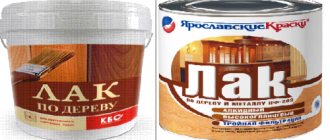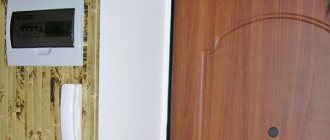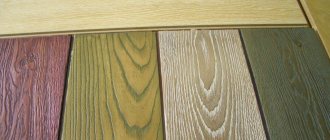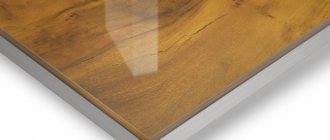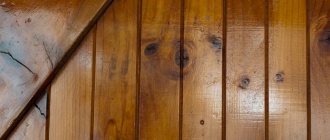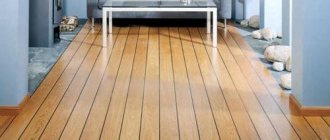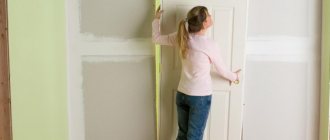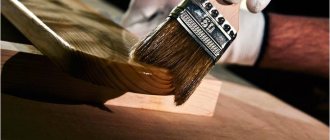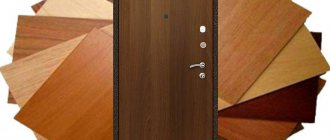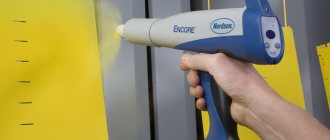At first glance, painting wooden doors seems like an easy and quick process. Indeed, if you are painting a door in a country house or in a barn, this is not at all difficult to do, but if you want to get the perfect result, you will have to try. How to cover a wooden door is up to you; it can be any suitable type of paint or varnish. Well-known manufacturers, as a rule, offer high-quality coating options. Take preparation for painting seriously too. All the nuances are in the next article.
How to paint wood
In the modern building materials market there is a large selection of coloring compositions
In the modern building materials market there is a large selection of coloring compositions. The choice in favor of one or another substance is determined by your desire to preserve the natural beauty of the tree or make its appearance more original and unusual. There are several types of dyes:
- opaque enamel;
- acrylic, polyurethane, perchlorovinyl and oil paints;
- varnishes, tinted or transparent;
- stains and oil impregnations.
The latter are perfect for creating an original interior. They can refresh the color of a wood surface or give it a number of new shades. Experts in the field of construction and cladding recommend that beginning craftsmen give preference to water-based acrylic paints. Such substances are very convenient to work with a brush; they have excellent consistency and excellent spreadability. The ability to evenly cover the surface being treated is somewhat worse than that of oil paints.
Also, alkyd paints and varnishes are suitable for painting wooden doors. These substances have water-repellent properties, are resistant to frequent temperature changes and dry fairly quickly.
Alkyd paints can be used to paint both interior and exterior doors. They are also used to paint bath doors, thanks to the qualities described above.
If you choose these particular substances, you must take into account that they only paint completely dry surfaces. Otherwise, the layers of paint will very quickly become covered with cracks and many bubbles will form underneath them. In this case, the aesthetic appearance of the door will deteriorate significantly.
Tips for vertical painting
The painting process begins with the door frame, gradually moving towards the canvas. First, the door is painted closed, then it is opened slightly and gradually painted on opposite sides. The composition is applied from top to bottom, and it should be shaded correctly. At the end of the work, the structure is completely opened and the room is ventilated.
When using water-based paints, it is important to choose the right working tool. Flat brushes made from synthetic bristles or fibers are considered a suitable option. The main advantage is that they are designed for wooden surfaces. Also, the brushes do not create splashes, so the coating becomes beautiful and even.
A flat brush made of natural bristles is suitable for solvent-based coatings. To check the quality of the tool, you should pull it by the bristles; if it remains in your hands, it is not recommended to buy such a product. The dimensions of the product must correspond to the area to be painted. Elements measuring 50 mm are considered a suitable option; narrow brushes are purchased for hard-to-reach places.
The process of preparing for painting wood
Painting occurs in several important stages. Very often two different compositions of dyes are used. At the first stage, impregnation is applied. Whether it is tinted or not depends on the individual tastes of the owner. Next, a high-quality decorative coating is applied. It is very important that these substances can work together, creating a kind of tandem.
Please note that if you are treating a wooden surface with varnish, the use of drying oil is prohibited. You only need to use stain. If you decide to make the color of the canvas and jambs fresh, stain or oil impregnation will do.
In this case, it is necessary to apply several layers of the substance. The application process, depending on the surface, takes place in 2 or 3 stages.
Before painting, you need to prepare the wooden door itself. If you need to paint not only the canvas, but also the jambs and other door structures, you need to go through several stages.
- Removing the entire door structure from its hinges. It must be placed on 2 level supports (stools will do). When using an alkyd composition, which is caustic, it is better to carry out painting work outdoors away from people.
- Do not remove the canvas, but carefully block it with special mechanisms. The brush should have access to all door elements. Locking the door is necessary to prevent the door from closing during the painting process. In this case, the entire layer of paint will be damaged.
It is recommended to remove the door leaf, but if the peculiarities of its design and the rules of the environment do not allow this, you can use the second option. The fittings are also removable. If this is not possible, handles and fixed hinges are wrapped in paper or tape to secure them. However, foil works best. It will tightly fit important parts.
Interesting Facts. Adviсe
- It turns out that calculating the upcoming repair work of painting with odorless paint for interior doors is very simple. On average, the purely statistical formula is as follows: paint consumption is 100-250 grams per meter in one layer. Based on this, you can do your own calculations and know in advance how much paint you will need. But for a more reliable result, purchase paint for half the work. If the calculations are correct, then the second half can be calculated exactly according to the same scheme.
- All odorless paints contain mainly natural ingredients, especially acrylic ones.
- Important: painting work should be carried out at a room temperature of at least +10° C and at a humidity of no more than 75%. During this kind of finishing work and when drying the door leaf, it is necessary to prevent exposure to ultraviolet rays. A painted wooden surface can be fully exploited no earlier than one day after completion of painting work.
- Before painting, it is necessary to seal with masking tape all those areas that will not be painted. The door leaf can be painted with a large roller, with the exception of some small areas where a brush is better suited. Preparatory stages of work before painting the interior with odorless paint: how are they carried out? Secrets and tricks.
For better quality painting work, it is necessary to carry out preparatory work. Especially when it comes to painting doors with odorless paint. It certainly has a number of advantages, but it is very picky about the surface. Therefore, simply cleaning the door leaf from dirt and old paint is not enough.
Preparing the door surface
At the first stage, the old facing material is removed
This process has several stages. At the first stage, the old facing material is removed. This includes layers of paint, primer and putty. All this must be completely removed down to the wooden surface. Here it is ideal to use a high-quality hair dryer and then remove the material with a spatula. An alternative to such equipment is sandpaper or a grinder. In addition, you can use special wood removers.
Next, the surface of the wooden door must be carefully sanded and all kinds of defects on it must be eliminated. This includes cracks, scratches, dents and the like. At this stage, craftsmen often use sandpaper or a sander attached to a vacuum cleaner. This process must be performed with special care. Before proceeding with the next work, the surface of the door is carefully inspected to ensure quality.
Large imperfections are easier to completely cover up. If you plan to cover the door with varnish, oil or stain, the putty should be specialized for wood. In the case when opaque enamel is used, the color of the putty does not matter.
The packaging with putty indicates its drying time. It must be maintained, and only then the grinding process can be started a second time. Regular sandpaper is quite suitable for this. Deep dents can be easily repaired with putty that does not contain fiberglass.
Are all quick-dry interior door paints odorless?
There is a myth that absolutely all paint that dries quickly is the same legendary paint for interior doors that does not have a chemical smell. This is not entirely true. The fact is that there are a number of paints that dry relatively quickly, but it is impossible to say with confidence that due to this they do not have a pungent chemical odor. For example, alkyd enamel. This is the most common type of interior paint because it comes in a very wide range of rich shades and is legendary for its long service life. It is easy to use, just one layer of application is enough. And of course, everyone is attracted by the minimum price of the product. Savings during repair work always play a major role. It dries relatively quickly due to the fact that sometimes one layer is enough for painting. But its distinguishing feature is its pungent chemical smell. It is recommended to carry out the work in respirators and ventilate the premises for a couple of days. Or nitro paint! It is often mixed with varnish, due to which it does not dry for long, but is considered the most powerful toxic agent and in rare cases causes allergies.
Distinctive features of painting different types of doors
Old interior and entrance doors often have a high-quality frame and durable door leaf. Various models, even those made of valuable wood, lose their original luster over time.
The layer of paint that has accumulated over the years spoils the appearance of the doors and requires reconstruction.
The easiest and most affordable way to update the entrance structure is to cover it with new paint. Any home craftsman can handle this work; it is enough to know the features of door materials, modern varnishes and paints, and also follow painting technology.
The process of painting different types of doors has its own characteristics:
- Solid wood. Doors made of this material are smooth, heavy structures
Solid wood . Doors made of this material are smooth, heavy structures. This option conveys the natural structure of wood as much as possible. To update the array, you should choose a transparent varnish or glaze. If the canvas is outdated, then wood-look glaze will do.
- MDF. The design of such a door consists of sheets of particle board and insulation. Painting an MDF door is quite simple, but before doing this you should carefully prepare the surface.
- Paneled canvases. The frame is made of MDF, and the inserts are made of thin boards or sheets of plywood. Before painting, the structure will have to be disassembled into its component elements. Due to the large number of joints, panel doors wear out faster and require updating more often.
Staining a veneered wooden door
CMs based on aggressive solvents (nitro paint) are not used for painting veneer doors. Matt spots appear on the surface of such a canvas as a result of chemical influences. It is recommended to apply water-based, glyphthalic and polyurethane tinting varnish.
Preparatory work begins with applying a floor solution to strip the veneer door of the old layer of varnish. When the layer is removed, the veneer is primed. Apply paint to an already dry surface.
The varnish coating is completely changed if a large area of the door leaf is damaged. If only small scratches are visible, then these places are rubbed down and a small container of varnish with a selected color is purchased.
Preparation of doors made of other materials for application of CM
The preparation process is different for canvas made from other materials and has its own characteristics:
- MDF or chipboard canvas is prepared and painted in the same way as wood;
- the waxy dirt-repellent layer is removed from the canvas, which is lined with laminate. This is the top layer and removing it will be enough;
- If the gloss on the veneer is renewed, then a new coating is applied to the previous one. Only the top layer of varnish is removed first.
We recommend videos on the topic:
Optimal paint for doors
Thinking about the question: “What to cover the door with?” It is necessary to have a general understanding of paint and varnish products, their pros and cons. The range of all paints is usually classified into transparent and opaque.
The first category includes varnishes, special impregnations and protective glazes. Treatment with a transparent coating does not cover the natural color and pattern of the wood, but, on the contrary, emphasizes it.
Opaque paints include alkyd and oil-based coatings. The most commonly used paints are nitro paint, acrylic and alkyd enamel. Each of the listed colors has its own characteristics.
Alkyd enamel is the most affordable, available in a wide range of colors and shades. After drying, a durable coating resistant to external factors is formed. The material is wear-resistant, economical in consumption and dries relatively quickly.
A significant disadvantage of alkyd paint is the unpleasant odor that lingers in the room for about two days after painting. The fumes negatively affect the health of allergy sufferers and people with respiratory diseases. It is not advisable to use alkyd enamels in children's rooms.
A significant disadvantage of alkyd paint is the unpleasant odor that lingers in the room for about two days after painting.
Nitro paint has high aesthetic properties; the color palette of materials is superior to acrylic/alkyd enamels. Significant advantages include high wear resistance and strength. However, nitro paint is even more harmful to health than alkyd enamel. Paint fumes are very toxic; painting work is carried out only in well-ventilated areas in compliance with safety precautions. You cannot enter the room until the paint is completely dry.
Water-based acrylic enamels are best suited for painting interior doors. The composition is easy to apply, adheres well, and when drying there is no unpleasant toxic odor.
Disadvantages of acrylic paint: higher price and low durability. To increase the wear resistance of the coating and preserve the aesthetic appearance of the top, the paint is coated with a special acrylic varnish.
Varnish for wooden doors is more often used for solid wood structures. Varnishing, like painting, protects doors from humidity, bright light and other external influences.
There are clear and tinted varnishes. Some materials are used in conjunction with paints. The choice of one or another varnish depends on the result you want to get.
Tinted varnish gives the door a certain shade. Transparent conveys the color of natural wood tone on tone.
Advice. When buying varnish, you should pay attention to the drying speed. It is better to choose a quick-drying varnish - such varnish does not spread over the surface and is harmless to health.
Types of paint
There are many paint compositions available on the modern market. Each of them has unique features, advantages and disadvantages. In order to make the right choice, you need to know the distinctive features of each composition, which will be discussed below.
Alkyd paint
Among the huge abundance of paint and varnish products that are presented on the market, we can highlight alkyd enamel, which is in quite high demand. This door paint has a number of advantages such as water resistance and heat resistance. In addition, it can maintain color for a long time without fading. The widest range of colors is available, and the price of such paint is quite competitive and affordable to a wide range of consumers.
Neither type of paint is without its drawbacks. Alkyd enamel is not suitable for wooden structures. The fact is that the paint tightly clogs the pores of the wood, preventing the material from “breathing,” which can cause cracks. In addition, the paint smells unpleasant, and the smell takes a long time to dissipate. The need to ventilate the room for about two days is not suitable for everyone. In addition, the presence of odor should be taken into account when painting rooms intended for children (children's rooms).
Acrylic paint
Another type of paint is acrylic. It is also called enamel. Acrylic enamel is available in a wide variety of colors. It is worth noting that the painted surfaces have a matte sheen, which is not suitable for everyone. Another nuance is the need to apply varnish to the painted surface. Otherwise, if you ignore this rule, the surface may wear out, will not be strong enough, and will quickly lose its original appearance.
Among the disadvantages, it can be noted that painting with acrylic is quite expensive, since you also need to spend money on varnish. However, the enamel has almost no odor and dries quickly, which makes it possible to use it for painting any room, including children's rooms. It is recommended to use this paint for MDF surfaces.
Acrylic lacquer
Acrylic varnish is not a door paint in the truest sense of the word, but it can protect doors made from natural wood. The color of this varnish is transparent, which makes it possible to preserve the color and structure of the wooden surface. After applying varnish, the door looks fresher. In addition, dust adheres worse to varnish than to an uncoated surface.
Varnishes can be of various shades, skillfully using which you can achieve amazing results to achieve the desired color of the canvas - from the lightest to the darkest shades.
Thermal enamel
Instead of acrylic paint, you can use thermal enamel. This is a good analogue that is not inferior in quality to paint. Thermal enamel retains its color for a long time and does not have a persistent odor (the odor evaporates within an hour after application).
Nitropaint
If there is a desire to preserve the door leaf for a long time, nitro paint is used, the use of which will ensure the longest and most stable color of the treated surface. The peculiarity of this paint is that it is heat-resistant and is not afraid of high humidity.
The disadvantages include the fact that such paint contains toxic substances, which requires the use of a respirator. In addition, it has a not very pleasant odor, which is dangerous for people with allergies, as well as for children.
It should be noted that paint for doors installed in wet areas, for example, in a bathroom, must have special properties. Matte enamels should not be used for such rooms; they do not tolerate moisture and are quite difficult to maintain. It is necessary to pay attention to the markings, which indicate that the paint can be used in rooms with high humidity.
Choosing the color of interior doors
Today's range of paints allows you to bring to life the most daring design solutions for decorating a room. In modern design, three main trends in painting interior doors can be seen:
- delicate, light tones of blue, peach, green, pink, lavender;
- dark rich shades of brown, cherry, blue, chocolate;
- bright colors - orange, yellow, red.
When choosing a color, designers recommend adhering to some rules:
- Dark shades such as cherry, red walnut, dark chocolate will add sophistication and luxury to the living room. Light colors are well suited for decorating a bedroom and children's room, creating a cozy and comfortable environment.
- The snow-white bedroom set is combined with the same white door, decorated with golden panels.
- For a wooden house, it is better to choose solid wood doors coated with a transparent oil impregnation.
- A classic interior with antique furniture can be complemented with an artificially aged wooden door.
- The color of the door frame should be either lighter or darker than the color of the walls.
Criteria for choosing KM for a wooden door
When choosing a CM, the priority is the characteristics of the canvas. After studying it, choosing what paint to paint a wooden door is not difficult.
- The material consumption of the door leaf is affected by the material used to make the door leaf. It is clear that wood absorbs more dye than metal sheets. If the coating is purchased at a high price (Milanese walnut color), then reserves of drying oil are first made. It will reduce the absorption of CM. This means the consumption will decrease.
- The smooth or textured surface of wood is painted with a different number of layers. For a smooth finish, 2 coats are sufficient; for textured - several layers. In this case, the material is used with a thick consistency.
- For a new coating, the CM is selected taking into account the type of paint of the old layer. This will avoid the reaction of two CMs with different compositions. Otherwise, there is a possibility of getting a new layer covered with bubbles.
Useful video on the topic:
Previously, before choosing a CM, the installation location of the doorway is inspected and taken into account:
- how often during the day family members use the door;
- factors of the interzonal space where the interior door is installed are taken into account: temperature and humidity;
- Is it possible to carry out quality preparatory work?
Owner's wishes:
- the KM shade blends harmoniously with the entire interior. Combines with pieces of furniture standing nearby;
- The beauty of the wood pattern is emphasized by varnishes. For example, from this point of view, coniferous species are treated with glazes;
- You can hide flaws behind dark shades: dark walnut, oak;
- For owners who like to experiment and change their decor, easily removable paints are the best option.
If you voice your wishes to the seller, the products will be selected quickly.
How to paint a wooden door correctly
Required Tools
The first step is to take care of the tools. To work you will need:
- paint tray;
- paint brushes;
- gloves;
- rags;
- putty knife;
- masking tape;
- emery cloth;
- vacuum cleaner;
- flashlight - can be useful for conveniently searching for defects on the door leaf;
- stools (4 pcs.) or trestles (2 pcs.).
Materials you will need:
- putty;
- primer;
- paint or varnish;
- solvent.
Surface preparation
The first step is to take care of the tools
It is more convenient to work with the canvas removed. Therefore, the door is first removed from its hinges and placed on a support, for example, on 4 stools. If the door is to be painted with an alkyd composition, then it is better to carry out the work in the yard, on the terrace or balcony.
After removing the door, remove all fittings. Fixed handles and hinges can be wrapped in paper, secured with tape or wrapped in foil. Fix the lock mechanism and seal it with tape.
In order to paint the door correctly, it is necessary to properly prepare it. How smoothly the paint lies on the door depends on the quality of this stage. Preparation procedure:
- Remove old paint, putty and primer down to the wood. To make the work easier, you can use a grinding machine, sandpaper, or a special wood remover.
- Perform pre-grinding. This will help remove small dents, scratches and paint residue. Sanding is carried out with a grinder and medium-grain sandpaper. Vacuum the surface.
- Visible imperfections in wood should be filled with special putty. Pay special attention to the gaps between the decorative elements and the canvas, lintel and jamb.
- After the putty has completely dried, sand the door again with sandpaper - first medium-grained, and then fine-grained.
Advice. Wood that has darkened over time can be lightened with a solution of chlorine bleach and water in a ratio of 3:1, respectively.
Composition based on cellulose nitrate
Based on the durability of the coating, nitrovarnish or nitroenamel (NC) are distinguished. When working with coloring materials, wear protective equipment. They are toxic compounds that can cause allergies. Respirators are used, dye is applied to the door leaf on the street or in a room where there are no people. The high price of NC is offset by the high strength of the coating.
Door painting scheme
The painting scheme depends on the door design:
- Panel door. Painting occurs in three stages. It is advisable to use a roller - it does not leave marks or hairs and ensures uniform painting. Painting begins from the top corner of the door in a transverse direction from left to right. After applying the first coat, the paint should dry completely. The second layer is applied in the longitudinal direction, and the third in the transverse direction.
- Paneled door. First, use a brush to paint all the recesses in the canvas. It is important to avoid excess paint. Finally, the entire door is painted with a roller, following the order of painting the panel structure.
Price for odorless paint
But it is worth noting that all data is conditional, because daily changes in price ranges can vary greatly. But if you focus on the average statistical indicators, then they are as follows. On the building materials market, many manufacturers offer odorless paints. Thus, odorless metal paint has an average price of 110 to 170 rubles. per kg depending on packaging, and for wood from 150 rubles.
The price of packaged paint in cans is thirty percent more, which is why it is not recommended to use it for large volumes of painting work.
How to properly paint solid pine doors
Some designers are reluctant to use solid pine doors in the interior due to the presence of knots
The advantage of inexpensive pine is the pleasant aroma of pine needles, which adds peace to the home and promotes restful sleep. Pine is a soft wood and is therefore susceptible to environmental influences. To make the material more durable and wear-resistant, it is necessary to protect it with the right paint and varnish.
Some designers are reluctant to use solid pine doors in the interior due to the presence of knots. This deficiency can be corrected using tinted stain. The product will not disturb the wood grain, but will give it a noble shade.
Before painting, the surface must be puttied and sanded. Resin drips and pockets should be removed and the door leaf sanded.
Sequence of painting a pine door:
- Sanding. The door, both new and old, must first be treated with sandpaper.
- Clean the surface from dust.
- Prime the canvas. The primer promotes uniform application of paint and additionally protects the wood from rotting. For better antiseptic protection, it is recommended to use special impregnation.
- Staining. Using a roller, apply stain of the desired shade to the door. To completely paint the texture, opaque paints are suitable.
- Cover the door with varnish.
Three tips on how to choose odorless paint for interior doors
- In order to accurately determine the choice of paint and make the right choice, you need to pay attention to the door itself. What material is the door leaf made of and how easily it can be transformed. Door leaf made of metal profile, wood or plastic.
For doors made of wood, acrylic paint is best suited
Pros:
- does not contain odor,
- dries quickly,
- looks aesthetically pleasing
- has a long service life.
2. Pay attention to where the door is. If this is a bathroom or toilet, it is advisable to give preference to bathroom paint. The thing is that in addition to the absence of odor, the big advantage of this paint is its moisture resistance. That’s why it’s so perfect for sanitary facilities.
3. If you are planning a short-term renovation, because you simply do not have time for long cosmetic procedures, water-based paint is best suited, because... it dries faster than others. In just a few hours. The only nuance that may confuse the consumer is that this paint is produced predominantly in white. Light shades are not always appropriate in some interiors, but don’t despair. The composition of this paint allows you to add any dye and get the desired color.
Painting options for solid wood doors
Let’s add “bark beetles”, patinas, apply abrasions, having discussed in advance the intensity of artificial aging - we will get a masterpiece of antiquity in the “brocant” style, creating warmth and comfort in your home. Oak, in comparison with pine and spruce, is much heavier, has a dense structure and a unique, incomparable wood pattern.
Solid oak looks great both under varnish and under a moderate layer of paint. And if you approach the matter creatively, then with the help of brushing (highlighting the structure of the wood), tinting, patana and varnish, you can give oak that living warmth that no other material has. Add to this hardness (density) and operational reliability.
There are doors made of MDF that are white, primed specifically for painting, smooth, or with a clearly defined wood structure. They can also be painted in any other color according to your sample, the “RAL” standard or the catalog of paint manufacturers with the addition of patina. Besides varnishing! Doors made of MDF are very heavy and are afraid of moisture, so the ends of the panels at the top and bottom must be well impregnated with at least the same paint.
Before painting, you need to have a firm idea of what the joinery product will look like after painting.
Before painting, you need to have a firm idea of what the joinery product will look like after painting. A pre-painted sample on the same material will help with this. The fact is that the color of the paint after drying differs slightly from the printed image on the catalog of paint manufacturers and this may not be critical, but with the application of patina the base color will become slightly different. Another advantage of a pre-made sample is the visual determination of gloss intensity.
Your choice: completely matte, highly glossy or something in between. Matte coating is not recommended for products that have direct contact during operation.
For example, pushing the interior door away from you or closing it behind you with your palm, over time in a certain place the matte coating will begin to shine. Having been guided by the sample, before painting the main product, you can always make changes and add your wishes.
For high-quality painting or varnishing of wood products, special conditions are required. First. The separate room in which paint and varnish work will be carried out must always be clean from dust, well ventilated and sufficiently lit, air temperature 15 - 28 ° C, humidity 50 - 80%. Second. Availability of paint and varnish equipment. And the third is an important condition. Not all paint and varnish material is water-based. Having working fire extinguishers is simply a must, and smoking is not allowed at all.
Recommendations for painting interior doors
If updating the coating of the canvas is done with your own hands, then the tools and necessary compositions for preparing the surface are prepared in advance:
- sandpaper;
- putty knife;
- hair dryer;
- solvent;
- painter's tools (brush, roller);
- putty material;
- construction tape;
- primer composition.
Preparatory work
Before painting the door, preparatory work is carried out:
- Remove the old layer of dye using a hairdryer. If it is not there, then use a spatula and sandpaper. Vinyl composition and nitro paint are removed using a solvent. They are available on sale in gel, powder and liquid form. The solvent is applied to the old coating and left for a short time (the exposure time is indicated by the manufacturer on the container).
- When the canvas is cleaned, it is washed and putty is used to remove any deformations, cracks, or chips on it. The dried layer of putty is sanded with fine-grain sandpaper.
- The canvas is washed again to remove debris. You need to wait until it dries completely.
- To make it easier to prepare the door and paint it later, it is removed from its hinges.
- The fittings are covered with construction tape if it is not possible to remove them. They also preserve glass inserts. If several colors are applied, then you cannot do without adhesive tape.
- The primer composition is selected for a specific type of CM. It improves paint adhesion to wood and reduces dye consumption. Since the primer is chosen to match the paint, and the paint is chosen taking into account the location of the door, water-resistant materials with antifungal properties are needed for areas of high humidity.
- The door leaf is not primed if it is treated with stain. It acts as an impregnation because it penetrates deep into the structure of the wood. The canvas is sanded and cleaned of dust particles.
General Tips
The paint is applied to the door leaf with a roller, protrusions and small elements are painted with a brush. The spray gun is used when updating an MDF door.
The CM is applied in one direction; layering it towards each other is avoided. At the time of coating, the sun's rays should not fall on the door. Mosquito nets are placed in the room to prevent midges and mosquitoes from flying in. If they stick to the new layer, the work will need to be redone.
The number of layers applied depends on the structure of the wood (2-4 layers).
The movement of the brush starts from the upper left corner to the right. First, the recesses on the surface are painted, then the canvas itself is covered and the work is completed on the ends. Immediately after the last centimeter of the door is covered, the carpentry tape is removed. This must be done before the CM dries. If time is lost, the paint may be damaged along with the tape. The uniformity of the coating will be disrupted.
Color selection
The shade of the dye is selected taking into account the interior of the place where the door is installed, relying on the wishes of the owners. The surrounding interior items, the color of the wallpaper, and the flooring are taken into account.
White color is considered neutral. Light beige, shades of brown - a choice of classic colors. Red or green, any colors with a harsh tonality are troublemakers that increase tension.
Useful tips
- Before painting the doors, the structure must be carefully inspected and repaired.
During operation of veneered doors, the material may peel off at the bottom. The coating should be carefully separated from the door base, coat the underside of the veneer and panel with special glue, and press the elements using clamps. To ensure a tight and even fit of the veneer, you can lay boards or pieces of plywood on top. Painting should be started only after the glue has completely dried. - It is often necessary to sand and paint a door frame without removing it. To avoid staining adjacent surfaces, they must first be covered with masking tape.
- During painting, you need to squeeze the paint roller well so that drips do not form on the surface. Drips from the brush can be removed with an ordinary sponge. It is enough to blot the drip areas and “walk” with a roller.
- The hinges and latch lock are not painted, but are left in their original form.
- The protrusion of the frame, which often comes into contact with the door during opening/closing, is recommended to be painted 2-3 times, since these parts are regularly rubbed down.
- Before use, new brushes should be combed out and kept in water for several hours - this will soften the bristles.
- Painting protective tape from the door leaf or areas adjacent to the frame should be removed immediately after painting. If this is done after the paint has dried, some of the paint will be removed along with the tape.
- During the drying process, it is necessary to exclude the possibility of direct sunlight, midges and dust coming into contact with the painted surface.
Sources:
- https://strport.ru/dveri/kak-pravilno-pokrasit-dver
- https://drevocolor.ru/oformlenie.html
- https://bestmaliarka.ru/dveri
- https://element.ua/advice/pokraska_dverey_iz_dereva_i_mdf/
Painting with alkyd enamel
Painting interior doors involves several stages.
First stage. In order to carry out high-quality painting, you must first remove the door from its hinges, since if this is not done, paint smudges may form on the surface. Using a spatula and sandpaper, remove the old coating from the surface of the door, then thoroughly wash the door leaf and inspect it. If necessary, you need to putty all the chips and cracks, dry the door, sand it with sandpaper, wipe the door and prime the surface.
Sometimes it can be very difficult to remove several layers of old paintwork. It can be softened with a hair dryer or a blowtorch. Flame or hot air heats the paint until bubbles appear, after which it is removed with a spatula. If the doors have glass, they must be removed along with the fittings.
It is also possible to remove old paintwork from the door leaf using chemicals that are produced in the form of gels, liquids and powders. They are sold in various containers: bottled and packaged in aerosol cans. Such products are universal and perfectly dissolve vinyl, oil-based, alkyd and nitrocellulose paints. The paint and varnish composition is applied to the surface of the door leaf with a brush, roller or spray and left for 5-20 minutes.
Second phase. The door leaf prepared for painting must be laid on a horizontal surface, which must first be covered with polyethylene. A floor, table or workbench is suitable as such a surface. The glass in the door is sealed with masking tape. First of all, you need to paint the panels with a brush, then the protruding elements, and then roll the entire door leaf with a roller.
Advice! When applying alkyd paint in two layers, its consumption will be 40-80 g/m².
Third stage. You can also impregnate the door leaf with a special tinting composition, which uses paint based on natural oils. The newly applied tinting layer should be rubbed several times with a rubber spatula. The composition is absorbed by wood fibers, thereby changing the color of the door leaf.
To tint a door, instead of a spatula, you can use a sponge, which is dipped in paint and passed over the surface of the canvas, pressing firmly along the grain of the wood. The disadvantage of this option is that it is time consuming.
We paint MDF
How to paint MDF doors is not an easy task, but before you start work, you need to purchase the necessary materials and tools so that you are not distracted by searching for them while the work is being done.
- First of all, you need to choose a paint color; choosing a suitable shade is not difficult; this can be done through the manufacturer’s catalog. But if this option does not suit you, you can create a unique, exclusive paint color by mixing several paints at once, remembering to use paint from the same manufacturer.
- The paint for MDF doors can be quite different and you need to realize that it must necessarily have both moisture-proof and heat-resistant characteristics. Moreover, it must be strong, durable, and naturally not susceptible to any mechanical influences.
Attention: It is important to note that alkyd paints and car enamels are the most popular and in demand today. As soon as the paint is purchased, you need to purchase the remaining materials and tools that are necessary to carry out the work.
- Before purchasing, you should study the dye instructions. After all, the manufacturer may provide technology for coating and you need to know this.
Required Tools
Before deciding how to repaint MDF doors, you need to prepare the necessary tools; during work there will be no time to be distracted:
- Roller;
- Primer;
- Sandpaper;
- Painting tape, gloves and brushes.
These are the most important tools that must be purchased without fail.
Can MDF be painted?
Facades, furniture panels, panels, door cladding and other products made from MDF are in great demand due to their characteristics. This is the only material among analogues that can be processed in all possible ways: milling, figured cutting, lamination, laminating, painting. Let's take a closer look at the latter.
This beautiful kitchen façade can be achieved using painted MDF
Painting MDF is a complex process and it begins with the selection of the base material – paint and varnish. If you want to get a perfectly smooth surface with a semi-matte or glossy sheen, then simple oil paint PF-115, even from an expensive foreign manufacturer, is not enough. An inexperienced master will face several problems at once:
- High absorbency of slabs, especially on sharp corners and milled bevels. The facades of furniture, doors or panels can almost completely absorb up to 5 layers of alkyd enamel. Without proper preparation, grinding and polishing, the surface will be uneven, rough, and untidy in appearance and touch.
- During transportation, the unprotected surface of MDF becomes covered with a huge number of scratches, both large and small. The paint fills them and reveals them first. Long grinding and constant monitoring will be required.
- When working, a milling tool literally tears out individual fragments, which causes small holes, dents and other defects to appear. Therefore, in addition to fine grinding, puttying with finely dispersed liquid compounds may also be required.
- Panels, doors and furniture elements made of MDF are almost always installed vertically, so drips, unevenness of the layer, etc. may occur.
- When working with a brush or roller, a large amount of so-called wood fluff rises, therefore, to obtain a smooth surface, sanding is necessary after each applied layer of paintwork.
Small roughness on the surface of MDF is the same “wood fluff”
It turns out that MDF cannot be painted? Our answer is that it is possible, but it is necessary to use a whole range of products, or, in the language of professionals, use a special program of paints and varnishes, which include:
- Several types of primer compositions: barrier primers or insulators with a pore-filling effect, elastic and easily sanded multicomponent compounds, basic pigmented compositions with a solids content of at least 50%.
- Paint with high hiding power, thixotropy, and after polymerization - wear resistance and durability.
- To create a smooth surface with a glossy/semi-matte sheen: varnish or polishing kits (paste + nap disc for polishing).
Conclusion
To summarize, we can safely state that odorless paint for interior doors today is the most popular and profitable material. Painting work can be done both in summer and winter, because it:
- First. It is odorless and completely safe for households.
- Second. It dries quickly and will not cause any inconvenience during long painting works.
- Third, it’s easy to apply.
- Fourth - relatively budget-friendly. It may be a little more expensive than some competitive brands, but due to its advantages, this price difference does not particularly detract from the merits of the paint.
- Fourth. Allows use even in the presence of children. In particular, any acrylic.
- Fifth. Non-toxic and completely safe.
